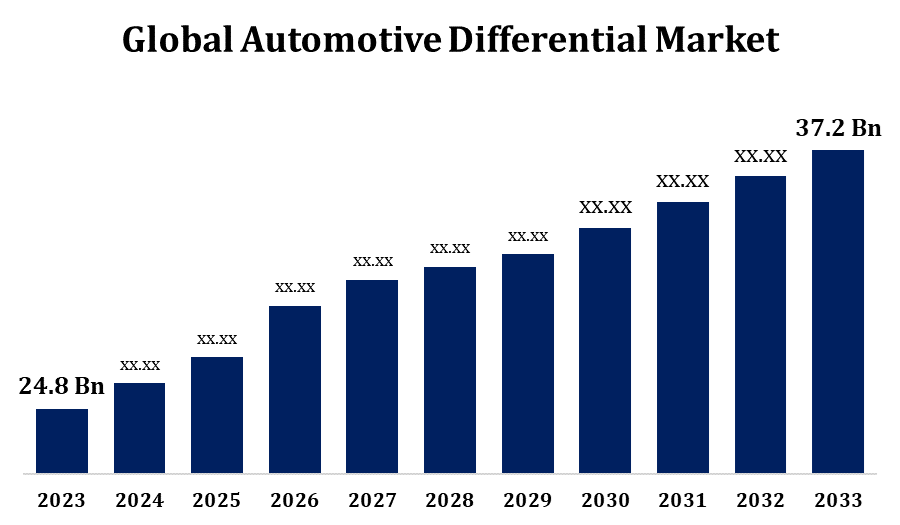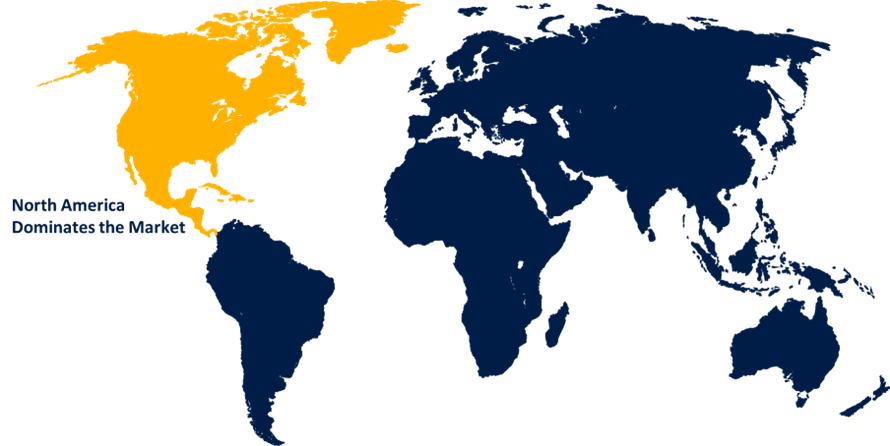Global Automotive Differential Market Size, Share, and COVID-19 Impact Analysis, By Differential (Open Differential, Limited-Slip Differential (LSD), Electronic Limited-Slip Differential (ELSD), Locking Differential, Torque Differential), By Drive (Front-wheel drive, Rear-wheel drive, All-Wheel Drive (AWD)/Four-Wheel Drive (4WD)), By Propulsion (Engine, Electric), and By Region (North America, Europe, Asia-Pacific, Latin America, Middle East, and Africa), Analysis and Forecast 2023 - 2033
Industry: Automotive & TransportationGlobal Automotive Differential Market Insights Forecasts to 2033
- The Automotive Differential Market Was valued at USD 24.8 Billion in 2023.
- The Market Size is Growing at a CAGR of 4.14% from 2023 to 2033.
- The Global Automotive Differential Market Size is Expected to reach USD 37.2 Billion By 2033.
- Asia Pacific is Expected to Grow the fastest during the Forecast period.

Get more details on this report -
The Global Automotive Differential Market Size is Expected to reach USD 37.2 Billion By 2033, at a CAGR of 4.14% during the Forecast period 2023 to 2033.
The Automotive differential Market is driven By increasing vehicle production, demand for fuel efficiency, and advancements in drivetrain technologies. Differentials play a crucial role in distributing torque between wheels, improving traction and stability, especially in off-road and high-performance vehicles. The market is expanding due to the rising adoption of all-wheel-drive (AWD) and four-wheel-drive (4WD) systems in passenger and commercial vehicles. Technological advancements, such as electronic limited-slip differentials (eLSD) and torque vectoring, are enhancing vehicle performance and safety. Asia-Pacific dominates the market, with rapid urbanization and industrialization fueling demand, particularly in China and India. Meanwhile, stringent emission regulations are pushing automakers to develop lightweight and energy-efficient differentials. The growing electric vehicle (EV) segment is also influencing differential designs, fostering further innovation in the market.
Automotive Differential Market Value Chain Analysis
The automotive differential market value chain consists of multiple stages, from raw material suppliers to end users. It begins with raw material procurement, primarily involving metals like steel and aluminum for differential casings and gears. Manufacturers and suppliers then process these materials into components such as ring gears, pinions, bearings, and housings. OEMs (original equipment manufacturers) integrate differentials into drivetrains, aligning with vehicle specifications. Tier-1 and Tier-2 suppliers play a crucial role in innovation, developing advanced technologies like electronic limited-slip differentials (eLSD). Distribution channels include direct OEM sales and aftermarket suppliers catering to replacement and performance upgrades. Finally, automotive service centers, repair shops, and end consumers complete the chain. Increasing automation and electrification are reshaping the value chain, emphasizing lightweight and high-efficiency differential systems.
Automotive Differential Market Opportunity Analysis
The automotive differential market presents significant growth opportunities driven by evolving vehicle technologies and increasing demand for advanced drivetrains. The rise of all-wheel-drive (AWD) and four-wheel-drive (4WD) systems in passenger and commercial vehicles boosts differential adoption. Electric vehicles (EVs) are reshaping the market, with innovative e-differentials and torque vectoring systems enhancing efficiency and performance. Growing consumer preference for off-road and high-performance vehicles further expands market prospects. Additionally, advancements in lightweight materials and smart differentials improve fuel efficiency, aligning with global sustainability goals. Emerging markets in Asia-Pacific, particularly India and China, offer lucrative opportunities due to rising vehicle ownership and infrastructure development. The aftermarket segment also provides growth potential, driven by increasing vehicle longevity and demand for differential replacements and upgrades.
Global Automotive Differential Market Report Coverage
| Report Coverage | Details |
|---|---|
| Base Year: | 2023 |
| Market Size in 2023: | USD 24.8 Billion |
| Forecast Period: | 2023-2033 |
| Forecast Period CAGR 2023-2033 : | 4.14% |
| 2033 Value Projection: | USD 37.2 Billion |
| Historical Data for: | 2019-2022 |
| No. of Pages: | 230 |
| Tables, Charts & Figures: | 110 |
| Segments covered: | By Differential, By Drive, By Propulsion, By Region and COVID-19 Impact Analysis |
| Companies covered:: | ZF Friedrichshafen AG (Germany), Eaton (Ireland), BorgWarnerInc. (US), Schaeffler AG (Germany), GKN plc (UK), JTEKT Corporation (Japan), Dana Limited (US), DREXLER AUTOMOTIVE (Germany), neapco (US) and others key players. |
| Pitfalls & Challenges: | COVID-19 Empact, Challenges, Future, Growth, & Analysis |
Get more details on this report -
Market Dynamics
Automotive Differential Market Dynamics
Increasing demand for commercial and heavy-duty vehicles
The growing demand for commercial and heavy-duty vehicles is a key driver of the automotive differential market. As industries such as logistics, construction, and mining expand, the need for high-performance trucks and buses rises, fueling differential adoption. These vehicles require robust drivetrain systems to handle heavy loads, rough terrains, and long-distance travel, increasing the demand for advanced differentials like limited-slip and electronically controlled variants. Additionally, stringent emission regulations are pushing manufacturers to develop fuel-efficient and lightweight differential systems, further driving market growth. The rise of electric and hybrid commercial vehicles also opens opportunities for innovative e-differentials, enhancing efficiency and torque distribution. Emerging economies, particularly in Asia-Pacific, are witnessing rapid infrastructure growth, boosting the sales of commercial vehicles and, in turn, accelerating differential market expansion.
Restraints & Challenges
The automotive differential market faces several challenges, including high manufacturing costs and complex integration processes. Advanced differentials, such as electronic limited-slip and torque vectoring systems, require sophisticated engineering and expensive components, increasing production costs. Additionally, the rise of electric vehicles (EVs), which often eliminate traditional differentials in favor of independent wheel drive systems, poses a potential threat to market growth. Stringent environmental regulations also pressure manufacturers to develop lightweight and fuel-efficient differentials, adding to R&D expenses. Supply chain disruptions, fluctuating raw material prices, and geopolitical uncertainties further impact market stability. Moreover, the increasing adoption of autonomous and connected vehicle technologies demands more advanced and intelligent drivetrain systems, requiring continuous innovation and adaptation, which can be a significant challenge for smaller market players.
Regional Forecasts
North America Market Statistics

Get more details on this report -
North America is anticipated to dominate the Automotive Differential Market from 2023 to 2033. The region's focus on all-wheel-drive (AWD) and four-wheel-drive (4WD) vehicles, particularly in off-road and performance segments, boosts differential adoption. Additionally, stringent fuel efficiency and emission regulations push manufacturers to develop lightweight, high-performance differentials. The rise of electric vehicles (EVs) is also influencing differential innovation, with automakers exploring e-differentials and torque vectoring solutions. The presence of major OEMs and technological advancements in drivetrain systems further support market growth.
Asia Pacific Market Statistics
Asia Pacific is witnessing the fastest market growth between 2023 to 2033. China, India, and Japan are key contributors, with high demand for passenger cars, commercial vehicles, and electric vehicles (EVs). The growing preference for SUVs and off-road vehicles further fuels the need for advanced differentials, including limited-slip and torque vectoring systems. Additionally, the region's push for fuel-efficient and lightweight drivetrain technologies aligns with stricter emission norms. The expansion of local manufacturing facilities by global automakers and the presence of strong domestic players enhance market growth.
Segmentation Analysis
Insights by Drive
The Front-wheel drive (FWD) segment accounted for the largest market share over the forecast period 2023 to 2033. FWD systems are widely used in passenger cars and compact SUVs, as they offer better space utilization, reduced vehicle weight, and improved fuel economy. The increasing production of small and mid-sized vehicles, particularly in emerging markets, is driving the demand for FWD differentials. Additionally, advancements in differential technology, such as electronic limited-slip differentials (eLSD), enhance traction and stability in FWD vehicles, making them more appealing to consumers. Strict emission regulations are also pushing automakers to optimize drivetrains for efficiency. With continued urbanization and growing vehicle ownership, the FWD differential market is expected to expand, particularly in Asia-Pacific and Europe.
Insights by Propulsion
The electric segment accounted for the largest market share over the forecast period 2023 to 2033. Unlike traditional internal combustion engine (ICE) vehicles, many EVs use independent electric motors for each wheel, reducing reliance on conventional differentials. However, the demand for advanced e-differentials, torque vectoring systems, and electronic limited-slip differentials (eLSD) is rising to enhance traction, stability, and energy efficiency. Automakers are also developing lightweight and high-performance differential solutions to meet stringent efficiency and range requirements. The increasing adoption of all-wheel-drive (AWD) and performance EVs, especially in premium and commercial segments, further drives market growth. As global EV adoption accelerates, differential manufacturers are investing in innovative solutions to stay competitive in this evolving landscape.
Insights by Differential
The open differential segment accounted for the largest market share over the forecast period 2023 to 2033. Open differentials are commonly found in front-wheel-drive (FWD) and rear-wheel-drive (RWD) vehicles, offering a reliable and efficient solution for standard driving conditions. The increasing production of economy and mid-range vehicles, especially in emerging markets, is driving demand for open differentials. Additionally, automakers are integrating advanced traction control systems with open differentials to enhance performance without significantly increasing costs. While advanced differential types like limited-slip and torque vectoring are gaining popularity, open differentials remain dominant in mass-market vehicles due to their affordability and ease of maintenance.
Recent Market Developments
- In January 2022, Dana Incorporated launched three new planetary drives featuring broad ratio ranges, enhanced power density, and modular designs, improving Spicer Torque-Hub compatibility for both tracked and wheeled vehicles.
Competitive Landscape
Major players in the market
- ZF Friedrichshafen AG (Germany)
- Eaton (Ireland)
- BorgWarnerInc. (US)
- Schaeffler AG (Germany)
- GKN plc (UK)
- JTEKT Corporation (Japan)
- Dana Limited (US)
- DREXLER AUTOMOTIVE (Germany)
- neapco (US)
Market Segmentation
This study forecasts revenue at global, regional, and country levels from 2023 to 2033.
Automotive Differential Market, Differential Analysis
- Open Differential
- Limited-Slip Differential (LSD)
- Electronic Limited-Slip Differential (ELSD)
- Locking Differential
- Torque Differential
Automotive Differential Market, Drive Analysis
- Front-wheel drive
- Rear-wheel drive
- All-Wheel Drive (AWD)/Four-Wheel Drive (4WD)
Automotive Differential Market, Propulsion Analysis
- Engine
- Electric
Automotive Differential Market, Regional Analysis
- North America
- US
- Canada
- Mexico
- Europe
- Germany
- Uk
- France
- Italy
- Spain
- Russia
- Rest of Europe
- Asia Pacific
- China
- Japan
- India
- South Korea
- Australia
- Rest of Asia Pacific
- South America
- Brazil
- Argentina
- Rest of South America
- Middle East & Africa
- UAE
- Saudi Arabia
- Qatar
- South Africa
- Rest of the Middle East & Africa
Frequently Asked Questions (FAQ)
-
1. What is the market size of the Automotive Differential Market?The global Automotive Differential Market is expected to grow from USD 24.8 billion in 2023 to USD 37.2 billion by 2033, at a CAGR of 4.14% during the forecast period 2023-2033.
-
2. Who are the key market players of the Automotive Differential Market?Some of the key market players of the market are ZF Friedrichshafen AG (Germany), Eaton (Ireland), BorgWarnerInc. (US), Schaeffler AG (Germany), GKN plc (UK), JTEKT Corporation (Japan), Dana Limited (US), DREXLER AUTOMOTIVE (Germany), neapco (US).
-
3. Which segment holds the largest market share?The electric segment holds the largest market share and is going to continue its dominance.
Need help to buy this report?